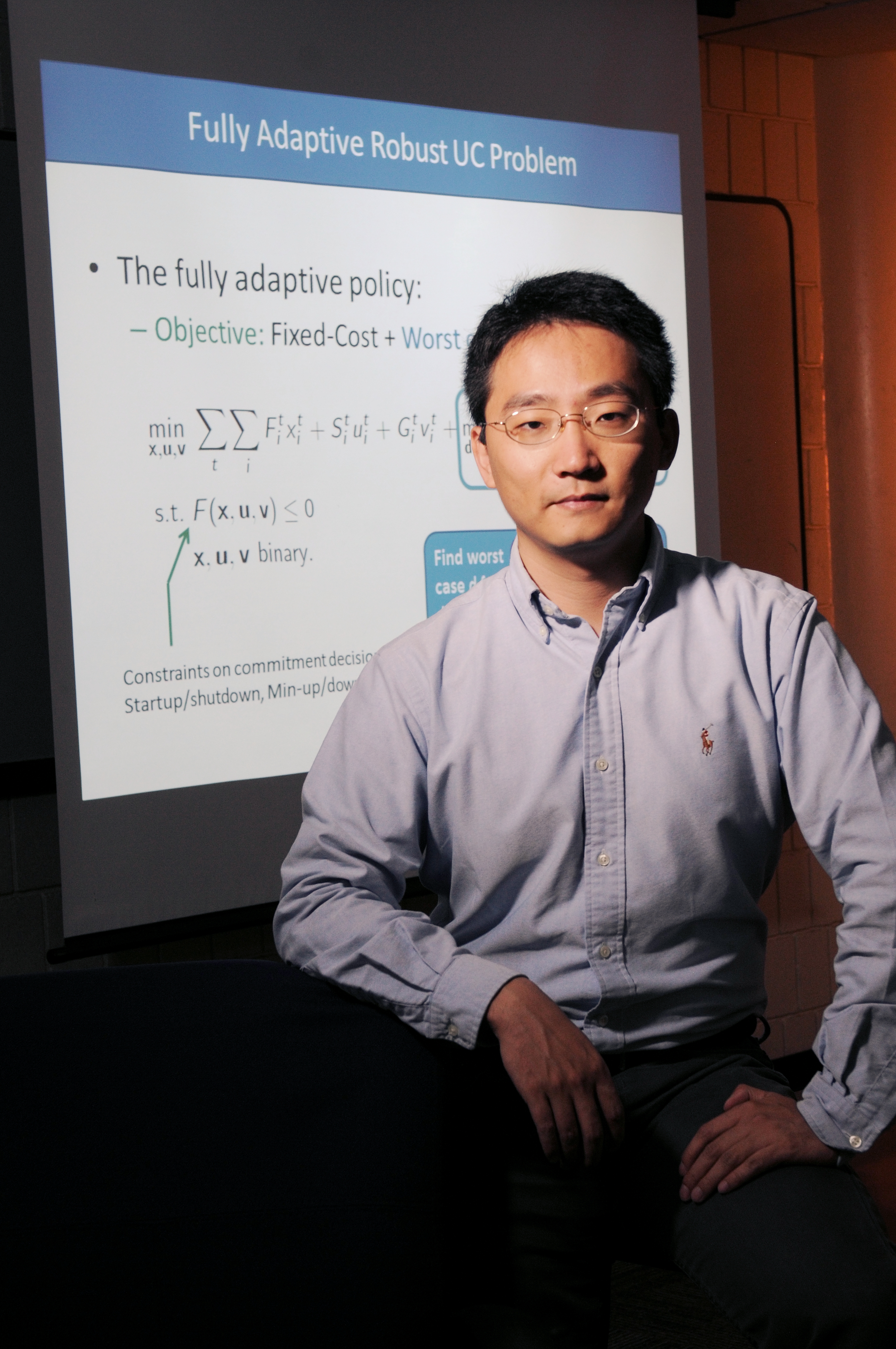On a warm afternoon in August 2003, a high-voltage power line in a rural area of Ohio brushed against some untrimmed trees, tripping a relay that turned off the power it was carrying. As system operators tried to understand what was happening, three other lines sagged into trees and were also shut down, forcing other power lines to shoulder the extra burden until they also tripped off, starting a cascade of failures throughout southeastern Canada and eight northeaster U.S. states.
Almost 10 years later, out electric power system continues to be challenged, by increasing demands of a digital society, the need to accommodate renewable energy generation, growing threats to infrastructure security and concerns over global climate change. The technology for a smart grid – with a two-way flow of electricity and information between utilities and consumers – could help address these challenges, but technical, regulatory and financial obstacles have slowed its deployment.
Researchers at Georgia Tech are helping to advance the smart grid. They are developing technologies, creating methodologies and analyzing policies that will allow for integration of renewable energy sources and electric vehicles in the grid, with dynamic electricity pricing, and improved assessment and monitoring of the grid and its components. Here are some highlights of how researchers at the Georgia Tech Stewart School of Industrial & Systems Engineering (ISyE) and their colleagues are researching and studying these issues.
Integrating Renewables into the Grid
The electricity grid is a large, complex system of power generation, transmission and distribution. High-voltage transmission lines carry power from large power plants to load center hundreds of miles away. Next, lower-voltage distribution systems draw electricity form the transmission lines and distribute it to individual customers. This long-standing electricity paradigm is being challenged as the grid becomes equipped with advanced sensing, communication, and control systems, and as an increasing quantity of power is generated by renewable sources.
Wind and sunshine constantly ebb and flow with the slightest weather shifts, creating a variable supply. So even when the renewables are going strong, conventional power plants must always be ready to step in and carry the load. Renewable energy sources – wind, sun, water, wood, organic waste, organic waste, and geo thermal – generated about 12 percent of the electricity in the United States in 2012. Increasing that percentage will require redesign of the power grid control architecture, scheduling framework and market mechanisms to balance supply and demand in the presence of these energy sources.
Integrating renewable electricity into the grid requires a transition by the electric industry from a centralized control architecture to a more distributed and flexible one that allows many actors to participate. To help accomplish that, Georgia Tech researchers in 2012 received a three-year, $2 million grant from the U.S. Department of Energy’s Advanced Research Projects Agency-Energy (ARPA-E) to develop and demonstrate a distributed electric power grid that would support high levels of renewable energy generation and storage.
The architecture is based on the emerging concept of electricity “prosumers” – a combination of the words “consumer” and “producer” – which are economically motivated small-scale energy ecosystems that can consume, produce, and store electricity. For example, prosumers could include homeowners who consume energy from the grid while also producing power onsite from solar panels on their homes’ roofs that feeds back into the grid.
“The power network from generation to transmission and distribution to consumption, needs to undergo the same kind of architectural transformation that computing and the communications network have gone through in the past few decades,” said Santiago Grijalva, associate director for the electricity at the Strategic Energy Institute and the Georgia Power Distinguished Professor in the School of Electrical and Computer Engineering (ECE). “We are taking one step toward transformation by developing a reliable architecture that will allow the electricity industry to operate with characteristics similar to the Internet – distributed, flat, layered, and scalable.”
To develop the architecture, Grijalva is collaborating with Marilyn Wolf, the Farmer Distinguished Chair in Embedded Computing Systems and a Georgia Research Alliance Eminent Scholar in ECE; Magnus Egerstedt, the Schlumberger Professor in ECE and a robotics expert; and Shabbir Ahmed, a professor in ISyE. The system will be backward compatible with the current electricity industry model, deployable by incrementally enabling prosumer services and interoperable with emerging smart grid technologies.
The system relies on a computational cyber infrastructure and an autonomous secure prosumer energy scheduler that allows small-scale producers to offer energy and grid services based on their capabilities and desire to achieve their sustainability, efficiency, reliability, and economic objectives, while contributing to system-wide reliability and efficiency goals. The researchers have teamed with industry partners ISISoft, PJM, Midwest ISo, and Duke Energy to demonstrate the architecture and software using realistic utility datasets. They are also exploring commercialization opportunities for the technology.
Craig Tovey, the David M. McKenny Family Professor in ISyE, is taking an inverse optimization approach to determining the least expensive way for a utility company to produce, store, and use electricity to meet demand in an area that contains prosumers.. Tovey and Tanguy Hubert, and electrical and computer engineering graduate student, are developing a computational model to determine what prices to offer small-scale producers to provide enough incentive that they will make production, storage, and use choices consistent with utility company’s optimal production plan.
“To solve this real-world inverse optimization problem, we need to decide what action we want the prosumer to take so that the overall goal is to achieve and then determine what price to offer so that when they minimize their own costs, they will select the action that is optimal for the general welfare,” said Tovey.
Andy Sun, assistant professor, has been collaborating with researchers at the Massachusetts Institute of Technology and ISO New England to create an adaptive optimization model that makes robust unit commitment decision and ensures system reliability, while considering real-time uncertainly from renewable energy.
“Wind and solar energy sources are intermittent and uncertain because they are greatly impacted by slight changes in weather and because predicting wind or sunshine amounts a day ahead can be difficult,” said Sun. “Unlike coal or natural gas plants, when wind farm is scheduled to generate 100 megawatts of electricity at 7 a.m., there is no guarantee that amount of power will be produced.”
With support from ISO New England, the team tested its model on the large-scale system operated by the organization and compared its model with the current approach of overcommitting generators to create a “just –in-case” reserve. Reserves can be expensive to maintain and ineffective due to the mismatch of supply and demand. The adaptive model demonstrated sizable savings on average operating and total costs and significantly reduced the volatility of the operating cost. A paper on the model was published in the February 2013 issue of the journal IIE Transactions on Power Systems.
In Europe, power exchanges run the day-ahead auctions, rather than independent systems operators, but the exchanges consider network constraints regarding system feasibly and reliability provided by the system operators. Sebastian Pokutta, ISyE assistant professor, and researchers from Friedrich-Alexander-Universitat-Erlangen-Nurnberg in Germany, created a model of the European electricity market, with support from the German Stock Exchange “Deutsche Borse Frankfurt.”
Determining the price of power in Europe has recently become more difficult with power market coupling, an initiative to integrate transmission allocation and power trading across national borders so that cheaper electricity generation in one country can meet demand and reduce prices in another country.
“While market coupling creates a more efficient market because of a strong interaction between price zones, it creates a very challenging real-world optimization problem that needs to be solved daily,” said Pokutta. “The market coupling optimization problem involves demand and supply orders of different exchanges that need to be matched to maximize the total gains from trade.”
Pokutta and his colleagues analyzed optimization techniques for determining the price of electricity that would maximize the financial surplus of all participants, while considering quantity and price constraints. The algorithms matched energy demand and supply for 24 hours and calculated all market prices, net positions, and cross-border flows at the same time.
Members of the European Union aim to deliver 20 percent of their energy from renewable sources, which is based on a target in the European Renewables Directive of 2008. The increase in renewable generation will require an intraday market that will allow for adjustments after the closure of the day-ahead market. Pokutta plans to create an intraday market model and combine the market models he has developed with atmospheric models to consider air quality, sustainability and energy generation together.
Examining the Effect of Electric Vehicles on the Grid
Electric vehicles could make it easier and cheaper to have renewables – particularly wind energy – on the grid and make it easier to manage electricity with its peaks at high demand times, according to the preliminary findings of a new study. The study was conducted by Valerie Thomas, the Anderson Interface Associate Professor of Natural Systems at ISyE; Deepak Divan, a professor in the School of Electrical and Computer Engineering; and their graduate students Dong Gu Choi and Frank Kreikebaum.
The researchers modeled the electricity system in six eastern and midwestern regions of the United States and are examining the interplay among the use, availability, and cost of different energy sources in those regions and electric vehicle adoption levels, electric vehicle charging methods, fuel economy standards, and renewable portfolio standards. Initial results from the study show how the time of day that users charge their electric vehicles affects how much electricity must be generated and the sources and costs of that power.
“Our preliminary findings indicate that controlled charging of electric vehicles reduces cost and makes it significantly less expensive to have large amounts of renewables in the electric system,” said Thomas. “The main cost saving is from reduced electric system capacity requirements.”
Controlled charging occurs when a driver plugs in a vehicle after completing the last trip of the day, but charging doesn’t begin until off-peak nighttime or early-morning hours when the cost of electricity is lowest. This contrasts with uncontrolled charging, when charging commences immediately upon plugging in the vehicle. Additional findings of the study detail the effects of electric vehicle adoption levels, electric vehicle charging methods, fuel economy standards, and renewable portfolio standards on gasoline consumption, electricity cost, greenhouse gas emissions, and consumer cost. The study is supported by the Intelligent Power Infrastructure Consortium, a university-industry-utility consortium that fosters and accelerates the development and adoption of early-stage, high-risk and high-impact technologies in power applications.
Assessing the Condition of the Grid
Predicting the degradation and remaining useful life of generators, transformers, and transmission lines could significantly improve the performance of the grid and reduce maintenance costs. Nagi Gebraeel, associate professor at ISyE, is developing methods for monitoring the degradation of power grid components and predicting their remaining lifetimes.
“Recent advances in sensor technology and wireless communication have enabled us to develop innovative methods for indirectly monitoring the health of different engineering systems and using that information in decision-making processes,” said Gabraeel.
Gabraeel has developed models that use data from real-time sensor measurements – such as vibration, temperature, insulation degradation, and partial discharge – to calculate and continuously revise the amount of remaining useful life of mechanical systems based on their current condition.
“We want to ensure the power grid remains reliable,” said Gebraeel. “Power utilities can no longer rely on time- or usage-based maintenance policies for generators or transformers. They need to be able to monitor the units in operation for up-to-date information on their condition and functionality to avoid unexpected failure.”
---
This article, written by Abby Robinson, has been excerpted from the full story that appears in the Spring-Summer 2013 issue of Research Horizons.
For More Information Contact
Barbara ChristopherIndustrial and Systems Engineering404.385.3102

